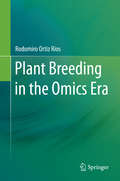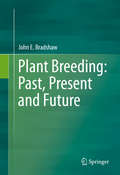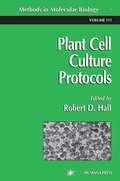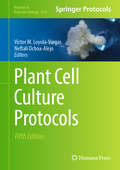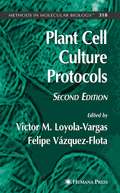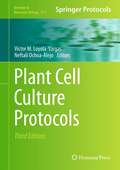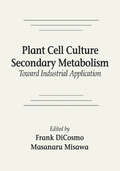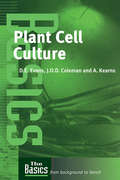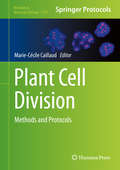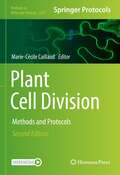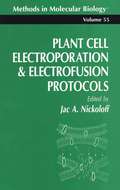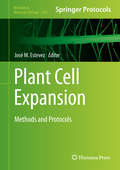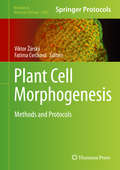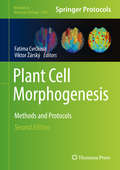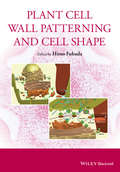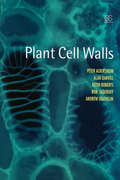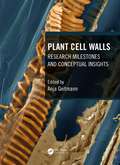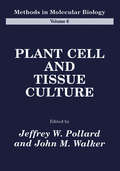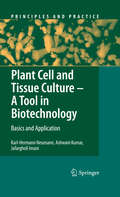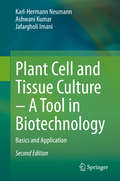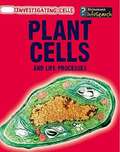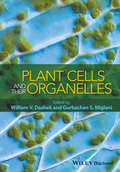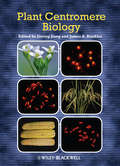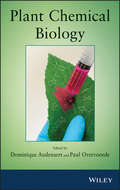- Table View
- List View
Plant Breeding in the Omics Era
by Rodomiro Ortiz RíosThe field of plant breeding has grown rapidly in the last decade with breakthrough research in genetics and genomics, inbred development, population improvement, hybrids, clones, self-pollinated crops, polyploidy, transgenic breeding and more. This book discusses the latest developments in all these areas but explores the next generation of needs and discoveries including omics beyond genomics, cultivar seeds and intellectual and property rights. This book is a leading-edge publication of the latest results and forecasts important areas of future needs and applications.
Plant Breeding: Past, Present and Future
by John E. BradshawThis book aims to help plant breeders by reviewing past achievements, currently successful practices, and emerging methods and techniques. Theoretical considerations are also presented to strike the right balance between being as simple as possible but as complex as necessary. The United Nations predicts that the global human population will continue rising to 9. 0 billion by 2050. World food production will need to increase between 70-100 per cent in just 40 years. First generation bio-fuels are also using crops and cropland to produce energy rather than food. In addition, land area used for agriculture may remain static or even decrease as a result of degradation and climate change, despite more land being theoretically available, unless crops can be bred which tolerate associated abiotic stresses. Lastly, it is unlikely that steps can be taken to mitigate all of the climate change predicted to occur by 2050, and beyond, and hence adaptation of farming systems and crop production will be required to reduce predicted negative effects on yields that will occur without crop adaptation. Substantial progress will therefore be required in bridging the yield gap between what is currently achieved per unit of land and what should be possible in future, with the best farming methods and best storage and transportation of food, given the availability of suitably adapted cultivars, including adaptation to climate change. My book is divided into four parts: Part I is an historical introduction; Part II deals with the origin of genetic variation by mutation and recombination of DNA; Part III explains how the mating system of a crop species determines the genetic structure of its landraces; Part IV considers the three complementary options for future progress: use of sexual reproduction in further conventional breeding, base broadening and introgression; mutation breeding; and genetically modified crops.
Plant Cell Culture Protocols
by Robert D. HallRobert Hall and a panel of expert researchers present a comprehensive collection of the most frequently used and broadly applicable techniques for plant cell and tissue culture. Readily reproducible and extensively annotated, the methods cover culture initiation, maintenance, manipulation, application, and long-term storage, with emphasis on techniques for genetic modification and micropropagation. Many of these protocols are currently used in major projects designed to produce improved varieties of important crop plants. Plant Cell Culture Protocols's state-of-the-art techniques are certain to make the book today's reference of choice, an indispensable tool in the development of new transgenic plants and full-scale commercial applications.
Plant Cell Culture Protocols (Methods in Molecular Biology #1815)
by Víctor M. Loyola-Vargas Neftalí Ochoa-AlejoThis fourth edition provides new and updated protocols on plant cell, tissue, and organ cultures. Chapters are divided into five parts that cover topics from general methodologies, statistical analysis and contamination control, highly specialized techniques, and laborious process of measuring the epigenetics changes in tissue cultures. Written in the highly successful Methods in Molecular Biology series format, chapters include introductions to their respective topics, lists of the necessary materials and reagents, step-by-step, readily reproducible laboratory protocols, and tips on troubleshooting and avoiding known pitfalls. Authoritative and cutting-edge, Plant Cell Culture Protocols, Fourth Edition aims to serve both professionals and novices with its guide to the most common and applicable techniques and methods for plant tissue and cell culture.
Plant Cell Culture Protocols (Methods in Molecular Biology #2827)
by Víctor M. Loyola-Vargas Neftalí Ochoa-AlejoThis fifth edition provides new and updated protocols on plant cell, tissue, and organ cultures. Chapters are divided into five parts that cover topics from general methodologies, statistical analysis and contamination control, highly specialized techniques, and laborious process of measuring the epigenetics changes in tissue cultures. Written in the highly successful Methods in Molecular Biology series format, chapters include introductions to their respective topics, lists of the necessary materials and reagents, step-by-step, readily reproducible laboratory protocols, and key tips on troubleshooting and avoiding known pitfalls. Authoritative and cutting-edge, Plant Cell Culture Protocols, Fifth Edition aims to ensure successful results in the further study of this vital field.
Plant Cell Culture Protocols (Second Edition)
by Víctor M. Loyola-Vargas Felipe Vázquez-FlotaA comprehensive state-of-the-art collection of the most frequently used techniques for plant cell and tissue culture. Readily reproducible and extensively annotated, the methods range from general methodologies, such as culture induction, growth and viability evaluation, and contamination control, to such highly specialized techniques as chloroplast transformation involving the laborious process of protoplast isolation and culture. Most of the protocols are currently used in the research programs of the authors or represent important parts of business projects aimed at the generation of improved plant materials. Two new appendices explain the principles for formulating culture media and the composition of the eight most commonly used media formulations, and list more than 100 very useful internet sites.
Plant Cell Culture Protocols (Third Edition)
by Víctor M. Loyola-Vargas Neftalí Ochoa-AlejoCell culture methodologies have become standard procedures in most plant laboratories. Currently, facilities for in vitro cell cultures are found in practically every plant biology laboratory, serving different purposes since tissue culture has turned into a basic asset for modern biotechnology, from the fundamental biochemical aspects to the massive propagation of selected individuals. "Plant Cell Culture Protocols, Third Edition is divided into five convenient sections that cover topics from general methodologies, such as culture induction, growth and viability evaluation, statistical analysis and contamination control, to highly specialized techniques, such as clonal propagation, haploid production, somatic embryogenesis, organelle transformation. The volume concludes with a section on the laborious process of measuring the epigenetics changes in tissue cultures."Written in the successful Methods in Molecular BiologyTM series format, chapters include introductions to their respective topics, lists of the necessary materials and reagents, step-by-step, readily reproducible protocols, and notes on troubleshooting and avoiding known pitfalls. Authoritative and easily accessible, Plant Cell Culture Protocols, Third Edition seeks to serve both professionals and novices with its guide to the most common and applicable techniques and methods for plant tissue and cell culture.
Plant Cell Culture Secondary MetabolismToward Industrial Application
by Frank DiCosmoPlant cell cultures are used extensively in studies of secondary metabolism, for the biosynthesis of pharmaceuticals, flavors, essences, and pigments. This book highlights recent developments in the in vitro growth of cultured plant cells and in the production of valuable secondary metabolites.Plant Cell Culture Secondary Metabolism details research on many exciting areas including:
Plant Cell Culture: Crop Species (The\basics (garland Science) Ser.)
by David Evans Anne Kearns Julian ColemanPlant cell culture is an essential methodology in plant sciences, with numerous variant techniques depending on the cell type and organism. Plant Cell Culture provides the reader with a concise overview of these techniques, including basic plant biology for cell culture, basic sterile technique and media preparation, specific techniques for various plant cell and tissue types including applications, tissue culture in agriculture, horticulture and forestry and culture for genetic engineering and biotechnology. This book will be an essential addition to any plant science laboratory's bookshelf.
Plant Cell Division: Methods and Protocols (Methods in Molecular Biology #1370)
by Marie-Cécile CaillaudThis volume aims to present a large panel of techniques for the study of Plant Cell Division. Plant Cell Division: Methods and Protocols captures basic experimental protocols that are commonly used to study plant cell division processes, as well as more innovative procedures. Chapters are split into five parts covering several different aspect of plant cell division such as, cell cultures for cell division studies, cell cycle progression and mitosis, imaging plant cell division, cell division and morphogenesis, and cytokinesis. Written for the Methods in Molecular Biology series, chapters include introductions to their respective topics, lists of the necessary materials and reagents, step-by-step, readily reproducible laboratory protocols, and tips on troubleshooting and avoiding known pitfalls.Authoritative and practical, Plant Cell Division: Methods and Protocols is a valuable tool for the study of plant cell division at both the cellular and molecular levels, and in the context of plant development.
Plant Cell Division: Methods and Protocols (Methods in Molecular Biology #2382)
by Marie-Cécile CaillaudThis new edition explores innovative approaches and keystone methodologies reflecting the recent advances in the field of plant cell division that have enabled us to study this fascinating process in a quantitative manner, at high resolution both in space and time using cell biology, biochemistry, and molecular biology. After a review of the methods used to visualize the actin cytoskeleton during plant cell division, the book focuses first on methodology to address mitosis progression as a part of the cell cycle. It continues with sections on manipulation of cell division, quantification of cell division patterning, as well as imaging and quantifying plant cytokinesis. Written for the highly successful Methods in Molecular Biology series, chapters include introductions to their respective topics, lists of the necessary materials and reagents, step-by-step, readily reproducible laboratory protocols, and tips on troubleshooting and avoiding known pitfalls. Authoritative and up-to-date, Plant Cell Division: Methods and Protocols, Second Edition serves as an ideal guide for researchers attempting to visualize, quantify, and modify cell division during cell cycle progression.
Plant Cell Electroporation And Electrofusion Protocols
by Jac A. NickoloffLeading experts and innovators describe in detail plant cell electroporation and electrofusion techniques for many types of plants. Their protocols cover a diverse set of plant cell types, including different cell types from a single organism (i.e., leaf cells and pollen) and the most important model plants, including maize and tobacco. Each protocol also contains detailed instructions for growth and growth optimization, protoplast generation, and protoplast regeneration for specific plant cell types, along with extensive troubleshooting advice and descriptions of expected results to simplify study design.
Plant Cell Expansion: Methods and Protocols (Methods in Molecular Biology #1242)
by José M. EstevezThis volume covers broad aspects of cell expansion in three different cell types: root hairs, pollen tubes, and hypocothyl cells. Chapters focus on the cutting-edge methods to study in detail several complex aspects of cell expansion such as secretion, endocytosis and recycling, cellular signaling and trafficking, and protein and polysaccharides cell wall biosynthesis in real time during cell expansion. Written in the highly successful Methods in Molecular Biology series format, chapters include introductions to their respective topics, lists of the necessary materials and reagents, step-by-step, readily reproducible laboratory protocols, and tips on troubleshooting and avoiding known pitfalls.Authoritative and practical, Plant Cell Expansion: Methods and Protocols is an essential reference book for plant scientist, molecular, and cell biologist as well as plant biochemists.
Plant Cell Morphogenesis: Methods and Protocols (Methods in Molecular Biology #1080)
by Viktor Žárský Fatima CvrčkováPlant Cell Morphogenesis: Methods and Protocols provides a collection of experimental techniques used in current research on the cellular aspects of plant morphogenesis. Methods and techniques include contemporary takes on classical light microscopy and histochemistry through automated microscopy applications, use of advanced optical tools, quantitative image analysis, study of cellular dynamics of apical meristems, specialized electron microscopy techniques, and methods used to study specific model plant cell types and protocols for using heterologous expression in yeast to study cell morphogenesis genes. Individual chapters in the highly successful Methods in Molecular Biology series format are written by expert researchers in the field and include introductions to their respective topics, lists of the necessary materials and reagents, step-by-step laboratory protocols, and key tips on troubleshooting and avoiding known pitfalls.
Plant Cell Morphogenesis: Methods and Protocols (Methods in Molecular Biology #1992)
by Viktor Žárský Fatima CvrčkováThis book collects techniques to continue exploring post-genomic land plant biology though the wisdom and skills accumulated from work on the founding molecular biology models that can now guide research into other species, including crop plants. Beginning with the visualization of plant cell structures, the volume moves on to cover digital image analysis protocols, qualitative and quantitative detection of the organization and dynamics of individual intracellular structures, the manipulation of intracellular structures, as well as techniques for studying model cell types. Written for the highly successful Methods in Molecular Biology series, chapters include introductions to their respective topics, lists of the necessary materials and reagents, step-by-step, readily reproducible laboratory protocols, and tips on troubleshooting and avoiding known pitfalls. Authoritative and fully updated, Plant Cell Morphogenesis: Methods and Protocols, Second Edition serves as an ideal source of inspiration for further research into the morphogenesis of plant cells, tissues, and organs.
Plant Cell Wall Patterning and Cell Shape
by Hiroo FukudaCell walls are defining feature of plant life. The unique and multi-faceted role they play in plant growth and development has long been of interest to students and researchers. Plant Cell Wall Patterning and Cell Shape looks at the diverse function of cell walls in plant development, intercellular communication, and defining cell shape.Plant Cell Wall Patterning and Cell Shape is divided into three sections. The first section looks at role cell walls play in defining cell shape. The second section looks more broadly at plant development. While the third and final section looks at new insights into cell wall patterning.
Plant Cell Walls
by Keith Roberts Peter Albersheim Alan Darvill Ron Sederoff Andrew StaehelinPlant cell walls are complex, dynamic cellular structures essential for plant growth, development, physiology and adaptation. Plant Cell Walls provides an in depth and diverse view of the microanatomy, biosynthesis and molecular physiology of these cellular structures, both in the life of the plant and in their use for bioproducts and biofuels. Plant Cell Walls is a textbook for upper-level undergraduates and graduate students, as well as a professional-level reference book. Over 400 drawings, micrographs, and photographs provide visual insight into the latest research, as well as the uses of plant cell walls in everyday life, and their applications in biotechnology. Illustrated panels concisely review research methods and tools; a list of key terms is given at the end of each chapter; and extensive references organized by concept headings provide readers with guidance for entry into plant cell wall literature.Cell wall material is of considerable importance to the biofuel, food, timber, and pulp and paper industries as well as being a major focus of research in plant growth and sustainability that are of central interest in present day agriculture and biotechnology. The production and use of plants for biofuel and bioproducts in a time of need for responsible global carbon use requires a deep understanding of the fundamental biology of plants and their cell walls. Such an understanding will lead to improved plant processes and materials, and help provide a sustainable resource for meeting the future bioenergy and bioproduct needs of humankind.
Plant Cell Walls: Research Milestones and Conceptual Insights
by Anja GeitmannPlant cell walls have been relevant for human survival throughout evolution, from cell walls recognised as an essential ingredient in human and livestock nutrition, to their use in energy generation, construction, tool making, paper and clothing. This plant-generated material is at the centre of a myriad of human activities, and it represents the world's most abundant natural resource for fuel, fibre, food and fodder. Plant Cell Walls: Research Milestones and Conceptual Insights provides an overview of the key discoveries of hundreds of years of plant cell wall research. With chapter contributions from prominent scientists in the cell wall field, this book provides a comprehensive treatment of plant cell wall research, accompanied by a historical overview to illustrate how concepts have evolved, and how progress has been enabled by emerging technological advances. Plant Cell Walls: Research Milestones and Conceptual Insights elaborates on the translation of research to application in biotechnology and agriculture, and highlights its relevance for climate change mitigation and adaptation. It will be a key resource for plant cell biologists, biochemists and geneticists.
Plant Cell and Tissue Culture
by John M. Walker Jeffrey W. PollardPlant Cell and Tissue Culture continues the high standards of Humana's Methods in Molecular Biology series. Its step-by-step approach (a hallmark of the series) is applied to a wide range of basic laboratory techniques and culture conditions appropriate to plant cells. Because of the diversity of cell types, species, and culture methods, much of this volume is devoted to the culture of particular cell types and to the regeneration of these cells into whole plants. Special attention is also given to the genetic modification of plants, as well as to the economic significance of plant products. Chapters cover a wide range of topics and techniques, including:* tissue culture media and selection * cryopreservation * callus culture techniques * organ culture * embryogenesis * batch culture * large-scale culture * hormonal control * fertilization techniques * gene transfer * cell immobilization * production systems * cell product purification * DNA expression * electrofusion of plant cells * mutant selection * mutagenesis techniques * automation * transfer of nuclei * protoplast culture * media analysis * micropropagation. A detailed appendix lists the formulas for the most commonly employed plant cell media. Comprehensive, easy to follow, and a pleasure to use, Pollard and Walker's Plant Cell and Tissue Culture is an essential tool for everyone--at all levels of proficiency and experience--involved in plant culture.
Plant Cell and Tissue Culture - A Tool in Biotechnology
by Ashwani Kumar Karl-Hermann Neumann Jafargholi ImaniThis book provides a general introduction as well as a selected survey of key advances in the fascinating field of plant cell and tissue culture as a tool in biotechnology. After a detailed description of the various basic techniques employed in leading laboratories worldwide, follows an extended account of important applications in, for example, plant propagation, secondary metabolite production and gene technology. Additionally, some chapters are devoted to historical developments in this domain, metabolic aspects, nutrition, growth regulators, differentiation and the development of culture systems. The book will prove useful to both newcomers and specialists, and even "old hands" in tissue culture should find some challenging ideas to think about.
Plant Cell and Tissue Culture – A Tool in Biotechnology: Basics and Application (Principles And Practice Ser.)
by Ashwani Kumar Karl-Hermann Neumann Jafargholi ImaniThis textbook is clearly structured with fourteen richly illustrated chapters and practical examples for easy understanding and direct implementation. The methods and findings developed in the authors’ group are presented in detailed, revised chapters. Readers will find valuable updates on the molecular basis of biotechnological processes, secondary metabolite production and genetic engineering. In addition, the basic principles of important biotechnologies, as well as examples of specially designed crops that deliver improved productivity under stress conditions, are presented. This second edition sets the direction for future research on the basic aspects of plant tissue culture and its applications in the fields of secondary metabolite production and genetic engineering. It provides both general and specific information for students, teachers, academic researchers and industrial teams who are interested in new developments in plant tissue culture and its applications.
Plant Cells And Life Processes
by Barbara A. SomervillThis book explores the features of the plant cell and their life processes.
Plant Cells and their Organelles
by Gurbachan S. Miglani William V. DashekPlant Cells and Their Organelles provides a comprehensive overview of the structure and function of plant organelles. The text focuses on subcellular organelles while also providing relevant background on plant cells, tissues and organs. Coverage of the latest methods of light and electron microscopy and modern biochemical procedures for the isolation and identification of organelles help to provide a thorough and up-to-date companion text to the field of plant cell and subcellular biology. The book is designed as an advanced text for upper-level undergraduate and graduate students with student-friendly diagrams and clear explanations.
Plant Centromere Biology
by James A. Birchler Jiming JiangPlant Centromere Biology is dedicated to plant centromere research. Chapters cover the structure of centromeres from several plant species including Arabidopsis thaliana, rice, maize, wheat and beet, while other sections cover several unique characteristics associated with plant centromeres, including classical and modern neocentromeres, centromere drive and centromere misdivision. Additional chapters are dedicated to epigenetic modification and evolution of plant centromeres, and development and application of plant artificial chromosomes. Written by an international group of experts in the field, Plant Centromere Biology is a valuable handbook for all plant scientists working on plant genome research. Beyond the bench, it can also serve as a helpful reference tool or textbook for upper level college classes on cytogenetics or genome analysis.
Plant Chemical Biology
by Dominique Audenaert Paul OvervoordeDemonstrates how advances in plant chemical biology can translate to field applicationsWith contributions from a team of leading researchers and pioneers in the field, this book explains how chemical biology is used as a tool to enhance our understanding of plant biology. Readers are introduced to a variety of chemical biology studies that have provided novel insights into plant physiology and plant cellular processes. Moreover, they will discover that chemical biology not only leads to a better understanding of the underlying mechanisms of plant biology, but also the development of practical applications. For example, the authors discuss small molecules that can be used to identify targets of herbicides and develop new herbicides and plant growth regulators.The book begins with a historical perspective on plant chemical biology. Next, the authors introduce the chemical biology toolbox needed to perform successful studies, with chapters covering:Sources of small moleculesIdentification of new chemical tools by high-throughput screening (HTS)Use of chemical biology to study plant physiologyUse of chemical biology to study plant cellular processesTarget identificationTranslation of plant chemical biology from the lab to the fieldBased on the latest findings and extensively referenced, the book explores available compound collections, principles of assay design, and the use of new research tools for the development of new applications.Plant Chemical Biology is recommended for students and professionals in all facets of plant biology, including molecular biology, physiology, biochemistry, agriculture, horticulture, and agronomy. All readers will discover new approaches that can lead to the development of a healthier and more plentiful global food supply.
